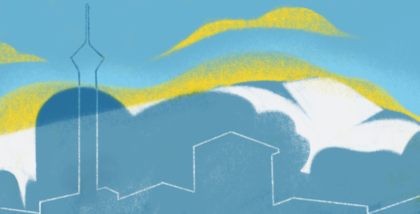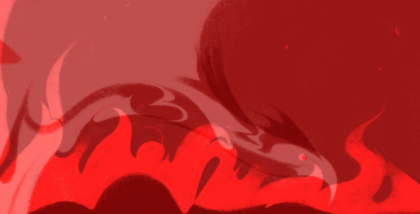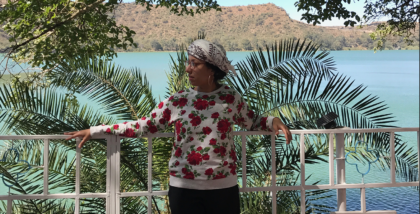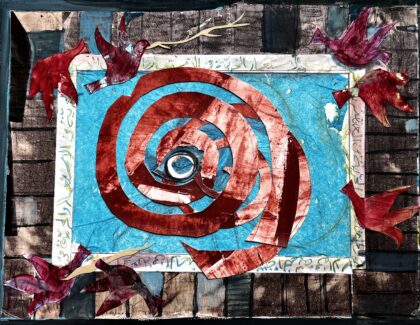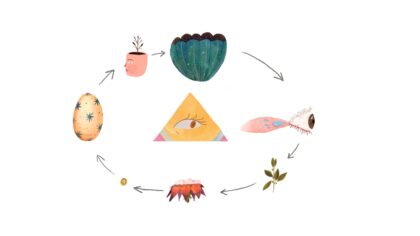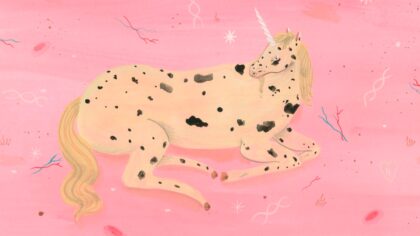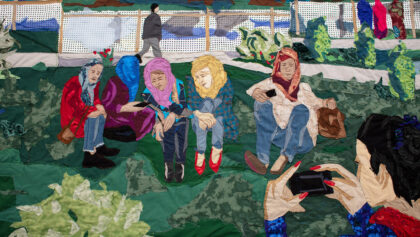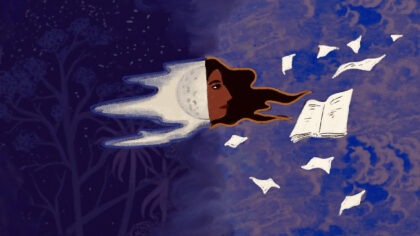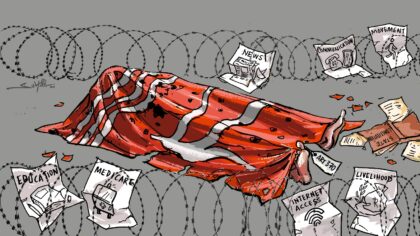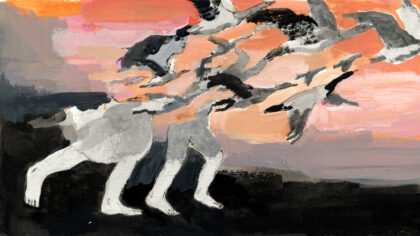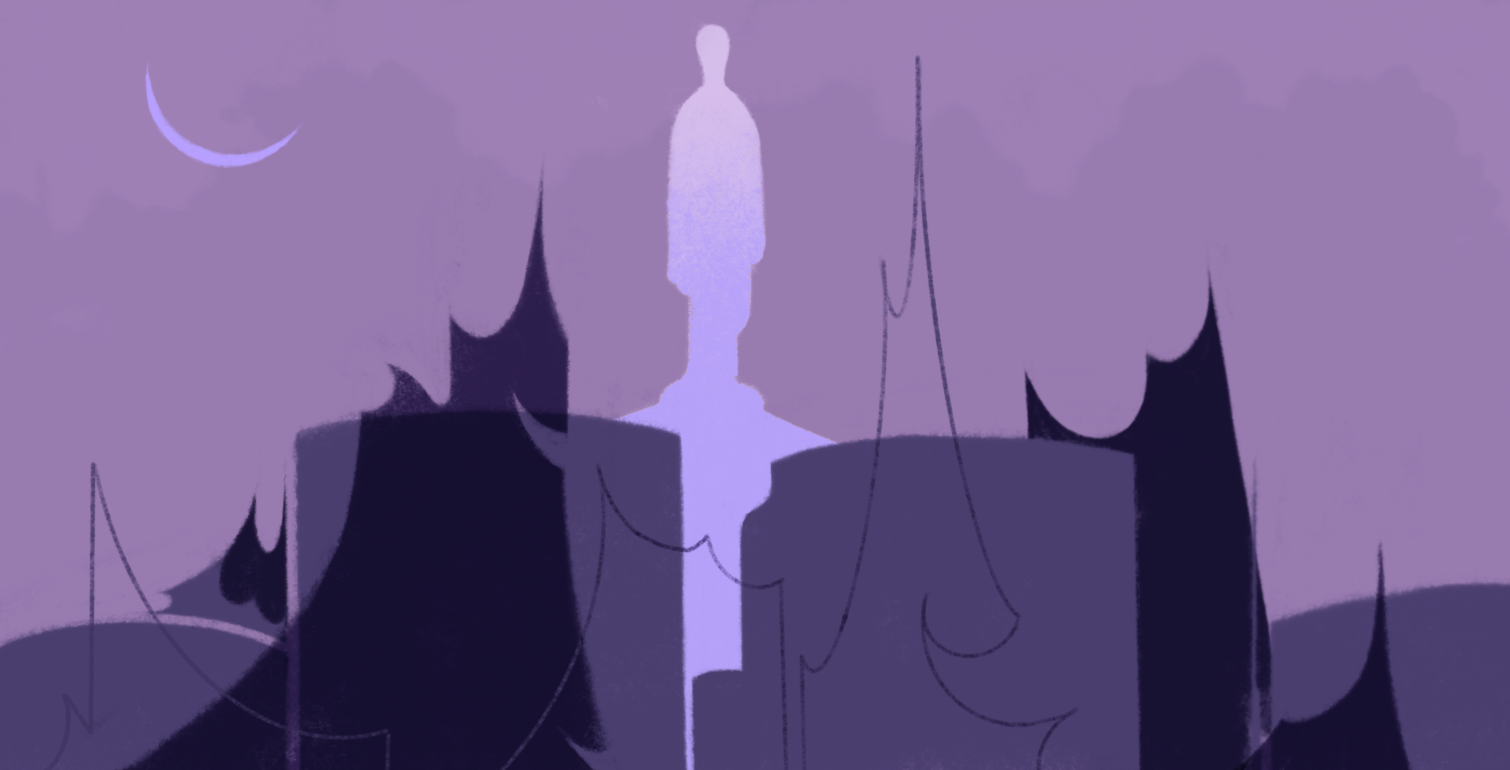 Illustration: Xia Gordon
Illustration: Xia Gordon
I participated in the committee for life and peace in Morón, against the drums of death that they wanted to bring for this people.
—William Peraza, Carabobo, Venezuela
William Peraza lives in the coastal town of Morón, in the northern Venezuelan state of Carabobo. In a storytelling workshop known as Misión Cultura, Peraza chronicles his life history. He recalls the 1980s, when the military made incursions into Morón to subdue revolutionaries, bringing, as he describes it, the drums of death.
The drums of death represent literal instruments of torture and killings, as well as the threat of violence used against leftists by the state. Peraza tells us that in the colonial era, Morón was home to runaway slaves and a base for organized slave revolts. He narrates a spirit of resistance that has been kept alive over decades and centuries, preserved within historical memory. I was part of a national gathering in Caracas about runaway slaves. This helped give form to our current struggle in the movement against racism and exclusion.
*
The New York Times shows a photo of an emaciated two-year old girl lying on a torn-up red rug. Her mouth is open in a desperate wail. Her tiny ribs show through her translucent skin, and her thin legs stick out of an oversized diaper.
The headlines on Venezuela read: starvation, hunger, corruption, famine, starvation.
The news media traffic in images of the dying. Some point to the crushing sanctions of the Trump administration for exacerbating the crisis. Mostly, they blame the country for bringing this catastrophe upon itself.
The mounting visual barrage of hunger, poverty, and dying Venezuelans is deemed stark evidence of a dying socialism. The project is moribund. The only outcome of equality can be starvation.
*
Today the drums of death arrive in the guise of a possible US-led military intervention.
A year ago, on January 23rd, 2019, 35-year-old opposition politician Juan Guaidó declared himself president of Venezuela. He was immediately recognized by Trump and many other Western nations. This, despite the presence of an elected president, Nicolás Maduro.
Trump and his advisors have aggressively pursued regime change in Venezuela. They have met with members of the defecting military in Washington, added the country to the travel ban list, and sent humanitarian aid planes and trucks to the Colombia-Venezuela border in provocation. Their economic sanctions have cut off essential medicine and food imports, and crippled public services.
Trump’s policy is increasingly overt, militaristic. But it is at its core bipartisan. Under Barack Obama, the US provided funding and training for opposition groups. Obama ordered sanctions against seven senior Venezuelan officials and designated Venezuela an “unusual and extraordinary threat” to US national security.
The news reports of starving children and debilitating blackouts, the painting of the Maduro administration as a violent and criminal dictatorship, all of these layers pile on to normalize the prospect of war, to make the removal of the president seem valid. A legitimate response to an extraordinary threat.
*
Fifteen years ago, I began to immerse myself in the subterranean cultures and collectivities of the urban barrios. Most reporting and research focused either on the charismatic figure of Hugo Chávez or on the opposition. The urban poor existed only as dupes of the Chávez regime or, as now, victims of a tyrannical despot. But I have sought the histories and experiences of barrios—why they chose to support Chávez, and how their own visions went beyond his.
*
Da-da, da-da-da. Da-da, da-da-da. When the slaves came to the New World, they brought the five-stroke clave. For centuries, the clave has functioned as sonic force and collective memory. It is the heart of an Indo-Afro-American socialism that Peraza and others are still fighting for, sometimes at odds, sometimes in beat with, the Maduro government.
The stories of the Misión Cultura reveal the long arc of resistance, from slave revolts through to movements against urban displacement in the ’70s, the leftist insurgency of the ’90s, and contemporary movements to reclaim public space and protest exclusion. These moments are linked through the cultural idiom of drums and religious fiestas. The Misión Cultura workshops were instituted by the Chávez government in 2005, alongside other social missions that provided healthcare, literacy training, soup kitchens, and subsidized groceries. In its founding statement, the Misión Cultura describes its aim to build a popular archive of people’s stories and histories, “to give words, voice, to us, the always silenced.”
Although the stories were not systematically collected and archived as intended, those that remain reveal the current of critical resistance that continues to pulse beneath the surface, belying the notion of a vanquished socialism.
*
In the 17th and 18th centuries, slave owners tried to prohibit the drums on their plantations. They were afraid of their power as a call to insurrection. The drums originated in Africa, but they speak to a hybrid cultural resistance that is also indigenous, Caribeño. They symbolize potency, plurality.
The drums have been a sign of life, a symbol of rebellion and survival.
Then and now, the drums, the tambores, have been a sign of life, a symbol of rebellion and survival.
A few years before Chávez came to office in 1999, Morón was occupied by military police. The ’90s had seen a rise in radical community-based activism from which Chávez himself emerged. In response, the state formed paramilitary units to subdue leftist movements. On June 24, 1995, Peraza and the cofradía, the brotherhood that organizes religious fiestas, took to the streets in defiance of the police to celebrate the Catholic-origin fiesta of San Juan Bautista.
We came out at five in the morning and baptized the saint in the river, Peraza described. With this, we said to the government in Morón that we are in the streets defending our rights.
The fiestas of San Juan and Cruz de Mayo are linked to the agricultural cycle. During the colonial era, San Juan, or St John’s Day, was the only day in the year when slaves were allowed to come together freely, to dance and play drums. While colonizers saw Saint John the Baptist as a bringer of civilization who would save heathen souls, the popular cult of San Juan that evolved bears strong traces of black influence. San Juan has been worshipped as a blond-haired and blue-eyed European figure. But the slaves also invested him with the power of an African god, incorporating ancestral drums and spirits.
In the course of my research, I heard stories about San Juan, as well as the cunning indigenous chief Terepaima, the black independence fighter Negro Primero, and religious deity Maria Lionza. These religious icons and mythical figures have cult followings in Venezuela, and in recent times they have been invoked by community leaders and featured in murals in the barrios, their names given to collectives and soup kitchens and community radio stations.
San Juan is the grounds upon which barrio residents elaborate their concerns, hopes, and desires.
*
I would take a plastic container, one of those that the Parmalat milk came in, a kilo. I removed the bottom and it became a cylinder. I sanded the edges and I bought a red sheet known as Teype, like those that electricians use. I started wrapping it on one diameter, passing it on all sides, in myriad ways, making the sheet stretch until it covered everything, leaving a uniform skin. This is how I made my first drum.
—Ricardo Guerrero, Caracas
Ricardo Guerrero is a rumbero, a drummer from the Caracas parish of La Pastora. In his life story for the Misión Cultura, he describes his childhood affinity for the drums. He couldn’t afford to buy one, so he made one for himself out of whatever was on hand.
Guerrero formed a guaguancó band with his friends Gusano and Tico. His mother took him to an amusement park called El Parque Mecánico, where he would hear music from the legendary salsa orchestras Sonora Matancera and Los Melódicos. I listened to the music with a certain nostalgia and sadness, perhaps because I was living as a child the complexity of my being. Guerrero suffers a condition of diastrophic dwarfism that involves knotted tendons in his joints and deformities in his feet and trunk.
Like Peraza, Guerrero also charts in his life story the aspirations for social justice rooted in cultural traditions that are ongoing today, despite economic hardship. Guerrero came of age in the 1970s during a moment of heightened cultural activism and regional political uprisings. Barrio communities were confronting government plans for urban remodeling that would eliminate the vibrant shanties and evict barrio residents. The state demolished the barrio of Saladillo, known for its rhythmical traditions of Gaitera. Guerrero formed a group known as Drummers against Displacement. He worked with a network of local organizations in street-based actions and consciousness-raising workshops.
Guerrero lived with his mother and siblings in a small rancho, a precariously constructed house in the upper reaches of the barrio Las Torres. In December 1999, the rancho collapsed in a storm and Guerrero was forced to live in a makeshift camp in the Parque Recreacional Sur.
In another Misión Cultura story, Sara Elena Pérez also recounts becoming homeless at the age of four, after a flood. In the Santa Bárbara parish where Pérez’s family was relocated, she was sexually molested by a neighbor. These darker experiences of gendered poverty also circulate through the stories, always an undercurrent.
Amid the traumas of displacement, rituals provide comfort. While in the camp, Guerrero recalls the altar of the Cruz de Mayo fiestas in Las Torres. Then, as now he finds life sustained in the fiesta.
Every year that passed we assembled a more beautiful altar, with an alcove of bamboo and palms. We added more ornaments, fruits and harvests from our land, the multicolors of nature and abundance, representations of the light that illuminates the path forward.
*
A pair of pale legs stick out from a crumpled cotton sheet on a bed. A cloth partially covers the open wound on the lower half of the left leg. In a photo essay for the BBC entitled “Venezuela’s silent decay,” photographer Ingebjørg Kårstad shares her current portraits of dying, beleaguered Venezuelans.
“It’s so silent,” Kårstad says. “How do you photograph people dying in a room, slowly?”
In the fantasy of the western artist, the dying Venezuelans are mute. They are silent and silenced. This silence is convenient. It allows the artist and the media behemoth to speak for them. They become spectacles of a catastrophic unraveling.
*
June 24, 2004. I join in a celebration of the San Juan fiesta in the historically black Caracas parish of San Agustín. Men, women, and children walk through the main street of the barrio waving a flag to purify the road ahead. I am with my friend Yajaira, who was born and raised in San Agustín.
These fiestas come from our ancestors who were slaves, Rosaria, a middle-aged black woman, tells us. And we are retaking them because these are our roots, this belongs to us.
The Metropolitana, the city police, try to intimidate the fiesta participants by circling the festivities in a shiny white jeep. At least twice in the past year, they showed up to fiestas and fired shots into the air to scare people. They are under the direction of the opposition-identified city mayor Alfredo Peña.
Raúl Britto, a fiesta organizer, offers people aguardiente, a sugarcane liquor, from a bottle slung around his neck. Chávez says, A mi no me mueve nadie—nobody outdoes me. And that’s San Juan now. The police also want to dominate us, but they are very mistaken. Who thinks that they can stop the drums of San Agustín here?
San Juan is a chameleon. He is a civilizing Catholic saint. He is San Juan Congo. He is a runaway slave. He is Chávez. He is the Yoruba god Shango. He is a garrulous drunk who likes to argue. He brings the force of the drums that is the voice of marginalized black and poor barrio residents.
We take San Juan up into the cerro, the hillside shanties, and people from the surrounding ranchos all join in the parade. In the high reaches of La Charneca, the group sings and dances traditional songs. Si San Juan lo tiene, San Juan te lo da.
As the procession comes down from the cerro, we confront a shootout between rival gangs.
A young man is killed in front of us. A crowd gathers around his body. The police arrive to cordon off the area. The singing stops.
The drums of death are present in the violence against leftists, in military coups. They are also here in the police and gang violence that has taken over the streets in recent decades. The everyday violence becomes routinized, but there is no getting used to the sight of a young person with a bullet in his chest lying lifeless on the ground.
I look over at Yajaira, who wears a somber expression. The year before, her youngest brother, a much beloved basketball coach from the parish, was shot in an exchange of fire between gang members in San Agustín and became paraplegic as a result. She has had to assume the work of caring for him. The shootings are sad; so too is the loss of an entire way of life, the days when one could be in the streets without fear.
In the midst of this, fiestas offer some reprieve. In the neighboring barrio, Carmen, in La Vega, community leader Williams Ochoa organized a celebration of San Juan in 2001, in the face of heightened street violence. A year later, his seventeen-year-old son was shot by a gang member during the San Juan fiesta. But Ochoa was determined to reclaim the neighborhood for the community. My son died. But come what may, we will never stop the fiesta of San Juan and we won’t forget the kids of the barrio, because these traditions are for them.
*
Venezuelans are eating dog food, reports Al Jazeera, or even stray dogs. They are cooking on the streets with firewood. People are searching for food in the trash. This in a country that just a few years ago was recognized by the United Nations for its food missions to reduce hunger. The food mission was created by the socialist government of Hugo Chávez and continued under Maduro, says Al Jazeera. Now it is failing.
Venezuela serves as the perfect vehicle for those who want to demonize socialism. Planet Money on NPR tells us that Venezuelans are starving because socialist policies under Chávez took away the economic freedom of the latifundios, the large agricultural corporations. Nationalization led to disincentives for food producers and stealing by corrupt government officials. The moral of the story: socialism fails because government control over corporations results in corruption and inefficiency.
In the face of deteriorating basic services, examples abound of barrios and rural farmers coming together to build alternative networks of distribution.
The country also acts as a bludgeon against those who aspire toward socialism in the United States. New York Times columnist Bret Stephens opines that in the age of Alexandria Ocasio-Cortez, we need to use the example of Venezuela to show all over again why socialism doesn’t work. For Stephens, government spending on social programs, raising the minimum wage, and an economy based on co-ops leads to deficits, inflation, shortages, and starvation. In the absence of the Soviet Union, Venezuela is a handy stand-in for the Cold War bogeyman.
But the Misión Cultura narratives offer stories beyond the sanctioned script. They tell of an Indo-Afro-American socialism based not just on nationalization but community control, one that emerges from cultural rituals and the creative force of everyday life.
Today the San Juan fiesta goes on, in the rural states of Carabobo, Aragua, Miranda, and Vargas, and in the urban centers like San Agustín. Si San Juan lo tiene, San Juan te lo da. And in the face of deteriorating basic services, the declining value of wages, and food scarcity, examples abound of barrios and rural farmers coming together to build alternative networks of distribution. Through the Unidos San Agustín Convive cooperative, one of hundreds across Caracas, barrio residents purchase bags of food from farmers in the state of Trujillo at fair prices and make products to give to rural communities in exchange. They see this as alleviating suffering while also building a self-governing socialist alternative.
The Alameda Theatre of San Agustín, a local theatre that was occupied and reclaimed as a “Culture House” by the community, has become a hub for organizers trying to find a collective way out of the crisis. In recent months, it has hosted gatherings of local organizations with the aim of redefining a democratic socialist horizon. The Cumbe Music Festival, named after the liberated territories set up by escaped slaves in the colonial era, was held at the Culture House in September. San Agustin itself is described as a cumbe, a vital space of peace and freedom today.
Da-da, da-da-da. Da-da, da-da-da. There is a rhythmic pulse, the clave. It continues, however faint, to strike notes of defiance and survival. We must learn to hear it.


